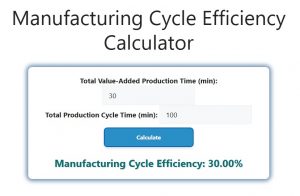About Manufacturing Cycle Efficiency Calculator (Formula)
Manufacturing Cycle Efficiency (MCE) is a vital metric used in production and manufacturing to assess the efficiency of a manufacturing process. It provides insights into how much of the production time is spent on value-added activities compared to the total production time. By calculating MCE, organizations can identify areas for improvement, reduce waste, and optimize production processes. The Manufacturing Cycle Efficiency Calculator simplifies this calculation, making it easier for businesses to monitor and enhance their operational efficiency.
Formula
The formula for calculating Manufacturing Cycle Efficiency (MCE) is:
MCE = VAT / PCT * 100
In this formula:
- MCE represents the Manufacturing Cycle Efficiency percentage.
- VAT stands for Value-Added Time, which is the time spent on activities that directly contribute to the product’s value.
- PCT signifies Total Production Cycle Time, which includes both value-added and non-value-added time in the manufacturing process.
How to Use
Using the Manufacturing Cycle Efficiency Calculator is straightforward. Follow these steps:
- Determine Value-Added Time (VAT): Calculate the total time spent on activities that directly enhance the product’s value.
- Identify Total Production Cycle Time (PCT): Sum up the total time taken for the entire production process, including both value-added and non-value-added activities.
- Input Values: Enter the VAT and PCT into the calculator.
- Calculate: The calculator will compute the Manufacturing Cycle Efficiency based on the provided inputs.
Example
Let’s walk through an example to illustrate the use of the Manufacturing Cycle Efficiency Calculator:
Suppose your manufacturing process includes:
- Value-Added Time (VAT) = 30 hours (the time spent on activities that add value to the product)
- Total Production Cycle Time (PCT) = 100 hours (the total time from start to finish of the production process)
Using the Formula:
Now plug in the values:
MCE = VAT / PCT * 100
MCE = 30 / 100 * 100
MCE = 30%
Thus, the Manufacturing Cycle Efficiency is 30%, indicating that 30% of the total production time is spent on value-adding activities.

FAQs
- What is Manufacturing Cycle Efficiency (MCE)?
MCE is a measure of how efficiently a manufacturing process converts raw materials into finished products by assessing the ratio of value-added time to total production time. - Why is MCE important?
MCE helps organizations identify inefficiencies in their manufacturing processes, enabling them to improve productivity and reduce waste. - What does Value-Added Time (VAT) include?
VAT includes all the time spent on activities that directly contribute to the product’s value, such as assembly, painting, and quality control. - What constitutes Non-Value-Added Time?
Non-value-added time includes activities that do not directly contribute to the product’s value, such as waiting, transportation, and inspection. - How can I improve my Manufacturing Cycle Efficiency?
You can improve MCE by reducing non-value-added activities, optimizing production processes, and enhancing workforce training. - Is a higher MCE always better?
While a higher MCE indicates a more efficient process, it’s essential to consider the overall production quality and customer satisfaction as well. - How is MCE different from Overall Equipment Efficiency (OEE)?
MCE focuses specifically on the efficiency of the manufacturing process, while OEE measures the efficiency of equipment performance, including availability, performance, and quality. - What is a good benchmark for MCE?
A typical MCE benchmark varies by industry, but many aim for at least 30-40% efficiency. However, top-performing organizations may achieve much higher rates. - How frequently should MCE be calculated?
MCE should be monitored regularly, such as monthly or quarterly, to track improvements and identify trends in manufacturing efficiency. - Can MCE be used in service industries?
While MCE is primarily a manufacturing metric, similar concepts can be applied to service industries to assess efficiency in value-added activities. - What tools can help in calculating MCE?
Various manufacturing software solutions can automate MCE calculations, providing real-time data and analytics for better decision-making. - How does employee training impact MCE?
Well-trained employees can enhance value-added activities and minimize errors, directly improving Manufacturing Cycle Efficiency. - Can MCE help in supply chain management?
Yes, by improving MCE, organizations can streamline their supply chains, reduce lead times, and enhance overall operational efficiency. - What role does technology play in improving MCE?
Advanced technologies, such as automation and data analytics, can help identify inefficiencies and optimize processes to improve MCE. - How can I calculate VAT effectively?
To calculate VAT effectively, analyze each step of the production process and track the time spent on value-adding tasks specifically. - What are common pitfalls in MCE calculation?
Common pitfalls include misidentifying value-added activities, overlooking hidden delays, and not considering variations in production processes. - Can MCE be applied to project management?
Yes, MCE concepts can also be adapted for project management to measure efficiency in completing tasks that add value to the project. - How can visual management techniques help improve MCE?
Visual management techniques, such as dashboards and Kanban boards, can help teams track progress and identify bottlenecks in the manufacturing process. - What are the benefits of regularly calculating MCE?
Regularly calculating MCE helps identify trends, monitor improvements, and establish benchmarks for continuous improvement. - Is it necessary to compare MCE across different plants?
Comparing MCE across different plants can help identify best practices, share insights, and improve overall performance within an organization.
Conclusion
The Manufacturing Cycle Efficiency Calculator is an essential tool for organizations aiming to optimize their manufacturing processes. By calculating MCE, businesses can identify areas for improvement, reduce waste, and enhance overall productivity. Regularly monitoring Manufacturing Cycle Efficiency allows organizations to maintain competitive advantages and drive continuous improvement in their operations. Using this calculator can lead to more informed decisions and a more efficient manufacturing environment, ultimately benefiting the bottom line.